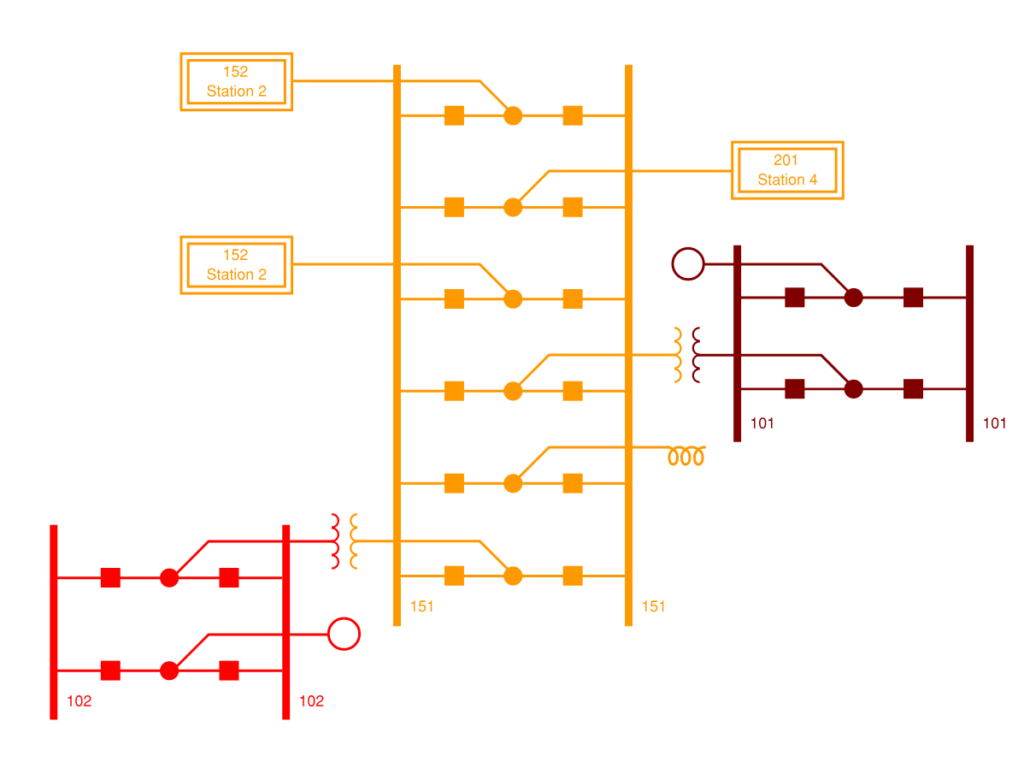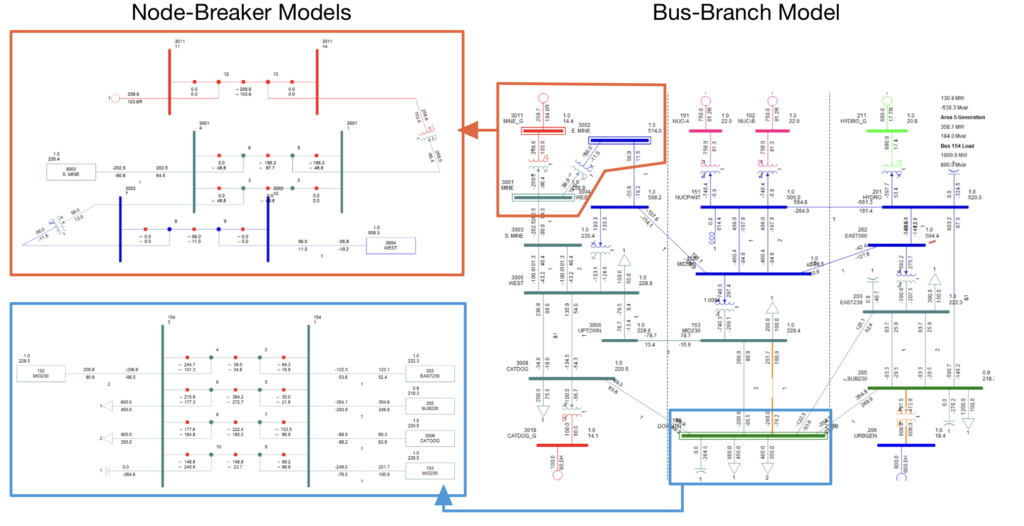Project Category: Electrical
Join our presentation
About our project
Our project involves Python programming and Power System Simulator for Engineering (PSSE) which is a high-performance transmission planning and analysis software.
PSSE is used to model complex power distribution systems. Older versions of PSSE only offered a “bus-branch” model, while newer versions have introduced a “node-breaker” model.
Node-breaker models include more details about the connections in the system at the substation level. This additional detail in PSSE allows for new ways to interact with the model. For example, with circuit breakers modeled, a system analyst can open or close breakers and test how the system will behave in that condition.
Our team has created a python program that takes a simple topographical input file about a substation and creates the corresponding model in PSSE. Additionally, the model is automatically validated by performing a power-flow analysis from the python program.

Meet our team members
Ali Campbell
David Bonin
John Kvellestad
Kara Tharp
Quinn Ager
Robyn Scholz






Details about our design

HOW OUR DESIGN ADDRESSES PRACTICAL ISSUES
- The design offers a practical means to automatically create node-breaker models for use in power system simulations. Power system simulation plays a critical role in the planning and operation of the power grid, and are used to:
- Determine the expected performance of electrical systems.
- Support the planning, design, and safe operation of utility assets.
- Manage the challenges from increased use of renewables, distributed generation, and electrification.
- Calculate and manage asset lifecycles.
- Develop contingency plans to ensure the safe and reliable operation of the power grid.
- Comply with the Independent System Operator (ISO).
- Node-breaker models offer several advantages by adding additional details not included in the traditional bus-branch representation of power systems. Providing a practical method to update the existing PSSE models to the node-breaker representation allows the design to support transmission system owners and operators.
Bus-Branch Model – The current limited model
- The bus-branch model lacks detail on the connections within a substation. Due to these limitations, contingencies involving circuit breaker failures must be manually simulated, which presents an opportunity for human error.
Node-Breaker Model – The new more powerful model
- The node-breaker representation better reflects the physical layout of utility assets inside a substation, allowing for more accurate power system simulations. Node breaker models give power system operators more actions to mitigate power grid congestion, reduce safety violations, and limit the size and frequency of disturbances.
Leveraging Python and automation
- Unfortunately, transitioning to a node-breaker PSSE model requires substantial effort due to the considerable number of electrical connections that need to be added to the model.
- Updating the entire AltaLink system would take a senior power system engineer a year of full-time effort. However, leveraging Python and the PSSE Application Programming Interface (API) provide a means to do this instantly.
WHAT MAKES OUR DESIGN INNOVATIVE
Node-breaker power system models are of high interest to transmission facility operators, system planners, and academia. The Western Electricity Coordinating Council (WECC) recommends that the power system planners transition to node-breaker models for future power system simulations. Accordingly, it is becoming prudent for power system engineers to invest time and resources into developing node-breaker models to ensure precise simulations. Due to the high expenses required and the likelihood of human error, automation using Python provides an innovative way to reduce human effort and increase accuracy when transitioning. Traditionally, a power system engineer interacts with PSSE through a user interface. This method is slow, error-prone, and cannot use robust testing practices available through the PSSE Python API. By leveraging Python, the project has provided a novel way to create node-breaker models instantaneously automatically, and accurately, without the need for direct human input.
WHAT MAKES OUR DESIGN SOLUTION EFFECTIVE
- The design effectively creates a node-breaker representation of a power system with minimal effort from the user.
- The solution produced only requires two inputs, (1) the existing bus-branch model for the system and (2) a Comma Separated Values (CSV) file containing the substation data needed to describe a node-breaker system.
- Both data sources are widely available to transmission facility owners and operators in Alberta, allowing the project to provide value to numerous organizations with minimal editing of existing code.
- Robust testing and validation are crucial to ensure a professional product. Integral to the design is errors and exception handling that tells a user when and where an error occurred with an easy-to-read message to notify the user. Offering a flexible and robust product provides the industry sponsor with an effective method of automatically updating PSSE models to the new node-breaker representation.
HOW WE VALIDATED OUR DESIGN SOLUTION
Power flow analysis offered a practical and thorough method of validating the accuracy of the product. Power flow analysis is the mathematical study of the flow of electrical power through a power system. Determining the bus voltages and active and reactive power flow allows the new node-breaker model to be measured against the original bus-branch representation. As the new node-breaker model is identical to the bus-branch model except for added detail within the substation, the overall power flow results should be exact for both topologies. Any deviation in power flow would indicate an error has occurred. Automatic power flow validation is added to the product test suite to guarantee that the new node-breaker model created is an accurate translation of the original bus-branch representation.
FEASIBILITY OF OUR DESIGN SOLUTION
The design ensured a feasible solution by following design criteria, including:
- No associated costs.
- Integrating with PSSE, which is the standard power system simulation program used in Alberta and elsewhere.
- Requires minimal input data that is common to power system owners and operators.
- Requires minimal alteration to accommodate variations in the formatting of input data.
- Except for PSSE itself, free and open-source Python libraries were used.
Partners and mentors
The team would like to express our sincere gratitude to all those who helped make our project a success. AltaLink sponsor, James Schwartz, for graciously offering his time, expertise, and guidance to ensure the team understood the problem and had the skills necessary for success. ENEL 500 teaching advisor, Anton Vykhodtsev, for giving the team continuous feedback and direction throughout the course deliverables and helping us consider all angles through challenging questions and insights. University of Calgary senior instructor, Seyed Pouyan (Yani) Jazayeri, for providing design guidance and review as the team’s academic advisor. AltaLink Capstone Coordinator Asher Waqar for allowing us the opportunity to learn and explore power systems. And lastly, our families and loved ones who have encouraged and sustained us during these challenging times.
Thank you.
